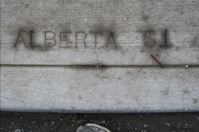I was out having beers with some friends last week when they were describing a recent cross country skiing trip. There was some talk of the danger of hills and it reminded me of my early days of skiing. My family had always been more of a cross-country family, and when we moved to Washington, my dad had started doing some backcountry skiing, and then some telemarking. I was interested in this, partly because it was different than regular alpine, but also because it was more wool than spyder and cowbells. My new friend Ben and his brother Troy were also their own telemark discovery period, so we bonded over the learning experience.
The learning experience was quite hilarious. When there was snow in Yakima we’d ski down to Franklin park with our cross-country gear. There were a couple places in the park where there was enough slope and sometimes enough snow to try and make telemark turns. We were using triple-N bindings and miniscule boots, and our skis lacked edges, so the turns only worked on the smoother, icier surfaces. All-in-all, our technique sucked and were were usually crowded off the terraces by sledders, if we hadn’t scraped off the snow with destructive skidding that we called “turns.” Once when there had been an especially big snow fall, we built a small ramp in the Manfredi’s back yard to practice our turns. It was a respectable amount of snow, and you could just barely complete one turn if you tried.
Eventually we got real backcountry gear – leather boots on sale at Svend’s, REI, or Feathered Friends, and some decent skis with edges and 3-pin bindings. It took about a year of ridiculous attempts at Franklin, up near White Pass, or even on some of the slopes up towards Chinook Pass that we were ready to take on a real ski slope. Our first trips were laughable, but we got better with each trip. Ben and Troy went up more frequently and got better quickly. I picked up what I could from my Dad and his friend Jack, but didn’t really “get” it until a trip to the pass with another fellow student who had a knack for criticizing people into improvement. He actually pointed out the difference between the wide scraping technique, and the real telemark turn.
After this revelation, we started getting pretty good. Once again, more gear was purchased, often more than once per season, but we’d elevated ourselves to a position of respect (or toleration) among downhill skiers and snowboarders alike. The Manfredi’s got really good and could out-ski anyone and really took telemarking to a new level. I never got that good, and was always a little more reserved, but could at least keep up for the most part.
One of the last outings I had with them (and the Hummels) was at Baker the year of the big snow. Before the avalanches that claimed several lives, we skied the arm of Shuksan and couldn’t believe our good fortune. We often hopped lifts without tickets to get up to the top and ventured out for backcountry. The last time we tried this, I got caught and was fined for theft of service. The guys all bought tickets after that, then took up kayaking. I haven’t skied for two seasons now, mostly out of cost, but also time. It’s going to be sad the first time when my thighs give out after an hour or two. At least I’ll be turning and not skidding.

